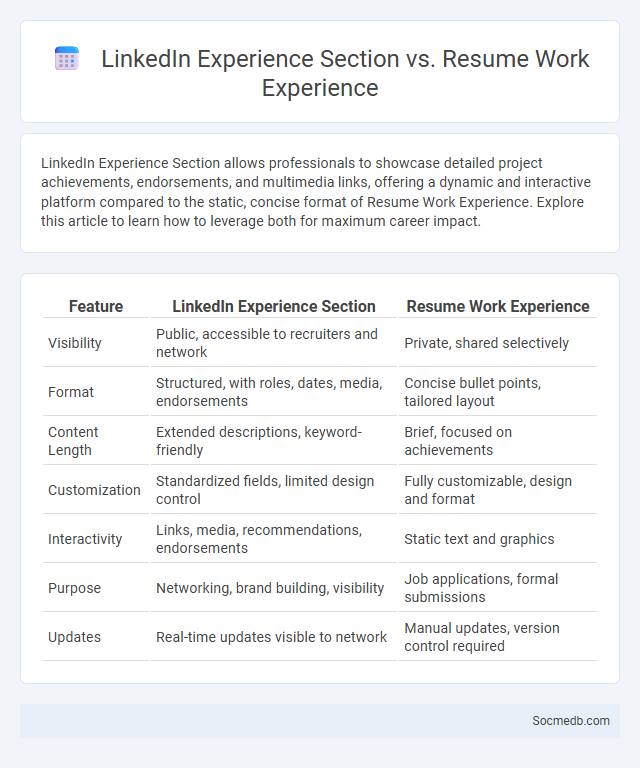
Photo illustration: LinkedIn Experience Section vs Resume Work Experience
LinkedIn Experience Section allows professionals to showcase detailed project achievements, endorsements, and multimedia links, offering a dynamic and interactive platform compared to the static, concise format of Resume Work Experience. Explore this article to learn how to leverage both for maximum career impact.
Table of Comparison
| Feature | LinkedIn Experience Section | Resume Work Experience |
|---|---|---|
| Visibility | Public, accessible to recruiters and network | Private, shared selectively |
| Format | Structured, with roles, dates, media, endorsements | Concise bullet points, tailored layout |
| Content Length | Extended descriptions, keyword-friendly | Brief, focused on achievements |
| Customization | Standardized fields, limited design control | Fully customizable, design and format |
| Interactivity | Links, media, recommendations, endorsements | Static text and graphics |
| Purpose | Networking, brand building, visibility | Job applications, formal submissions |
| Updates | Real-time updates visible to network | Manual updates, version control required |
Understanding the LinkedIn Experience Section
The LinkedIn Experience section showcases a user's professional history, highlighting job titles, companies, durations, and key responsibilities to build credibility and attract recruiters. Incorporating quantifiable achievements and industry-specific keywords enhances visibility in search results and aligns with recruiters' criteria. A well-crafted Experience section reinforces personal branding, demonstrating career progression and expertise within targeted sectors.
What is Resume Work Experience?
Resume work experience highlights your previous job roles, responsibilities, and achievements, providing potential employers with insights into your skills and expertise. This section should include accurate job titles, company names, employment dates, and specific accomplishments relevant to the position you are applying for. Showcasing measurable results in your work experience significantly enhances your resume's impact and increases your chances of landing your desired role.
Key Differences: LinkedIn vs Resume Experience
LinkedIn showcases a dynamic, interactive profile emphasizing professional networking, endorsements, and recommendations, while resume experience provides a concise, static summary tailored for specific job applications. LinkedIn allows for multimedia content, skill validations, and ongoing updates, creating a comprehensive digital presence. Resume experience prioritizes clarity and brevity, focusing on quantifiable achievements and relevant job history to capture employer attention quickly.
The Role of Resume Optimization
Resume optimization enhances your visibility to recruiters by incorporating relevant keywords and industry-specific terms from social media platforms like LinkedIn. By aligning your resume with trending skills and endorsements found on professional networks, you increase the likelihood of passing applicant tracking systems (ATS). This strategic integration ensures your qualifications stand out, attracting better career opportunities through social media channels.
Formatting Strategies for LinkedIn Experience
Effective formatting strategies for LinkedIn Experience include using clear job titles, concise bullet points, and quantifiable achievements to showcase your professional impact. Integrate keywords relevant to your industry and skills to enhance search visibility and attract recruiters. You can increase engagement by incorporating media such as presentations or project links that visually support your expertise.
Tailoring Resume Work Experience for Each Job
Tailoring your resume work experience for each job improves relevance by highlighting skills and achievements most aligned with the specific social media role. Emphasize measurable social media metrics such as engagement rates, follower growth, and campaign ROI to demonstrate impact. Customizing your resume increases your chances of passing applicant tracking systems and catching the attention of hiring managers.
Common Mistakes in LinkedIn and Resume Experience
Common mistakes in LinkedIn profiles include incomplete or outdated job descriptions that fail to highlight key achievements, which reduces visibility to recruiters using keyword searches. Resume experience sections often suffer from generic role summaries that lack quantifiable results, diminishing the impact of demonstrated skills and accomplishments. Ensuring precise, keyword-rich entries aligned with industry standards significantly improves professional branding and job search success.
Best Practices for Resume Optimization
Optimizing your resume for social media platforms involves incorporating relevant keywords and phrases that align with your target industry and job roles, ensuring your profile is easily discoverable by recruiters. Leveraging LinkedIn's features such as customized headlines, detailed summaries, and endorsements enhances your professional credibility and visibility. Keeping your information up-to-date and engaging with industry-specific content demonstrates your active involvement and expertise to potential employers.
Integrating Achievements and Keywords
Integrating achievements and keywords into social media profiles enhances visibility by aligning content with platform algorithms and audience interests. Highlighting specific accomplishments alongside industry-relevant terms increases credibility and attracts targeted connections or followers. Consistent use of optimized keywords within posts and bios drives engagement and improves search rankings across platforms.
How to Align LinkedIn and Resume Experiences for Job Search
Aligning your LinkedIn profile with your resume is critical for a consistent and professional job search presence. Ensure that job titles, responsibilities, and achievements are mirrored accurately while tailoring keyword optimization for LinkedIn's algorithms and ATS systems used by recruiters. Highlight measurable results and industry-relevant skills on both platforms to strengthen Your personal brand and increase visibility to potential employers.
 socmedb.com
socmedb.com